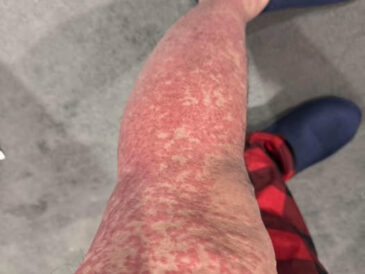“They’re not just strange,” the expert continued, lowering his voice to a whisper. “They’re potentially hazardous. We need to evacuate immediately. Whatever’s inside could be highly reactive—or worse, contagious.”
The word “contagious” hung in the air like smoke. Fear struck the family like lightning. The house that had always been a safe haven suddenly felt alien, threatening, and unwelcoming. Without waiting for more explanation, they began gathering essentials—phone chargers, clothes, their documents—while leaving most belongings behind. Every creak of the floorboard seemed amplified, every shadow a potential threat.
Lily clutched her stuffed rabbit, whispering reassurances to herself, while her parents moved with hurried precision. The atmosphere in the house was thick with tension. The eggs, innocuous in appearance, had turned their home into a place of danger. The expert carefully bagged the eggs in sterilized containers, ensuring minimal contact, while warning the family to keep their distance.
As they stepped outside, a cold wind blew, carrying the scent of fallen leaves and damp earth. For the first time, Lily felt an unfamiliar chill—not from the air, but from the sense of being exposed to forces beyond her comprehension. Her small town, usually familiar and safe, felt suddenly alien.
Authorities later arrived to assess the situation. Scientists and environmental specialists examined the eggs, using infrared cameras, microscopes, and chemical tests. Their findings were both alarming and fascinating. The eggs contained life forms previously undocumented by science. Their cellular structure was unique, combining traits of reptiles, amphibians, and an unknown organism type. Some experts suggested that the eggs might be remnants of an experimental lab project, while others speculated that they could be a rare natural mutation.
Despite the scientific intrigue, the family could not return to their home. The authorities cordoned off the area, installing monitoring devices to track any changes in the eggs’ activity. The house sat silently, its windows reflecting the dim autumn sunlight, while inside, those mysterious eggs pulsed faintly, a constant reminder of the unknown that had invaded the family’s life.
For Lily, the event left an indelible mark. She often woke at night, imagining the eggs hatching, imagining strange creatures crawling through the house. Her dreams were vivid, filled with glowing eyes and soft, rhythmic tapping sounds. Even mundane things—the warmth of her blanket, the feel of her pillow—reminded her of the eggs’ subtle vibration.
Her parents, meanwhile, struggled with guilt and fear. They had done what experts advised, but leaving behind their home, their memories, and their possessions felt like a personal loss. They often found themselves staring at empty walls, haunted by the image of the eggs and the thought of what might have emerged had they stayed.
Experts, meanwhile, continued to monitor the eggs. Preliminary observations suggested that they were extraordinarily resilient. Even when exposed to extreme temperatures and conditions, they remained intact, pulsing with life. The scientific community expressed both awe and concern—on one hand, the discovery opened possibilities for understanding new forms of life; on the other, it posed questions about how such creatures could appear in a suburban home, so far from any known natural habitat.
News of the incident spread quickly, capturing public imagination. Headlines in local and national papers read: “Mysterious Eggs Found in Suburban Home,” “Family Evacuates After Unusual Discovery,” and “Experts Investigate Unknown Life Forms.” Social media buzzed with speculation—some claimed alien origins, others insisted it was a secret government experiment, and a few suggested a hidden prehistoric species had been preserved underground, now revealed by the ordinary routines of a family living quietly in their home.
Lily’s story became a cautionary tale, a reminder that the ordinary world could hide extraordinary surprises. Her experience highlighted the thin line between safety and danger, the fragility of human assumptions in the face of the unknown.
Even as the eggs were carefully transported to a research facility, their influence lingered. The family had to relocate temporarily, moving into a small apartment with bare essentials, their lives disrupted in a way they had never imagined. Everyday routines—cooking, sleeping, studying—were now overshadowed by the fear of what had once been under Lily’s bed.
For months, Lily’s parents debated whether they could return home. Insurance companies, authorities, and scientific experts all weighed in, but uncertainty remained. The eggs were unlike anything anyone had seen, and the long-term risk could not be calculated. For the family, the house was no longer a place of comfort—it had become a symbol of the unknown, a home haunted by the invisible presence of life forms beyond comprehension.
Lily, however, found a strange kind of resilience. She became fascinated with biology, often asking questions about the eggs’ structure, growth, and origin. What had terrified her at first gradually transformed into curiosity, a desire to understand the extraordinary. Her parents supported her, cautiously encouraging her scientific interests while maintaining strict safety measures at home.
The eggs, now in secure containment, continue to puzzle experts. They are studied, measured, and observed, but the exact nature of what lies within remains a mystery. Some scientists argue that these life forms could hold secrets to biological resilience, rapid adaptation, or even novel biochemical processes. Others caution that such unknown life forms could carry unseen risks.
For Lily’s family, life has returned to a semblance of normalcy, but they carry the memory of that day with them. It is a story they will tell cautiously, a mixture of fear, wonder, and respect for the mysteries that exist just beyond human understanding.
The incident serves as a reminder to all: the world is full of hidden surprises, and sometimes, danger—and discovery—can lie in the most familiar places. What was once a quiet afternoon of searching for a toy turned into an extraordinary journey into the unknown, a story that will stay with Lily and her family forever.
Even today, when Lily passes her old bedroom, she shudders—not at the dust or the empty corners, but at the memory of the small, pulsating eggs that once changed her life. She knows that life can hold wonders and terrors in equal measure, often in places we least expect.





